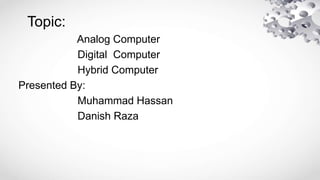
Analog Computer.pptx
- 1. Topic: Analog Computer Digital Computer Hybrid Computer Presented By: Muhammad Hassan Danish Raza
- 3. Analog Computer • is special type of computer, where to use data in continuously form, not discrete form. It uses some physical facts continously variable for solving problem such as mechanical, hydrolic and electric quantity. • Analog Data: changeable continues stream of data is known as “Analog Data” Analog Computer was first used in 1930.
- 4. Components of Analog Computer: Precision resistor Precision Capacitor Operational Amplifier Multiplier Potentiometer Fixed Function Generator
- 5. Working: • Analog Computer solves problems by representing variable and constant with voltage. • These quantities are then manipulated by electronic circuit that perform math. • They are not suitable at all for general purpose computing aplications.
- 6. Use of Analog Computer: • It is used in such area where to need data t be measured directly without transforming into numbers. • For example: in scientific and industrial areas. • Examples: Analog Clock, castle dock, slide ruler etc.
- 7. Disadvantages: Less Speed Less Accuracy Low Memory High Power Consumption Has No Statics Performance is Low Difficult to Use
- 8. Digital Computer – In Digital Computer, all the calculations and other operations are represented in the form of digit such as binary system “0” and “1”.
- 9. Components: • CPU • Computer Memor ( RAM and ROM) • InPut Divices • Out Put Divices
- 10. Working: • A digital Computer use Binary Number System which has two digit 0 and 1. • A binary digit is called “Bit”. • Information in digital Computer is represented in form of bits. • By Using various coding technique, group of bit use to made represent not only binary numbers but also other discrete symbol such as decimal digit or letter of alphabet.
- 11. Advantage: – Good Memory – Very Flexible – Automatic – Good Speed – Accurate
- 12. Disadvantage: – Digital Circuit use more energy analog to accomplish some task. – Digital circuit are more expensive. – Sampling Error
- 13. Five Generations of Digital Computers: Micro computer Mini Computer Mainframe Computer Super Computer
- 14. Usage: • It is used for Storing data such as Photo, musics, documents. • It is used for performing complex mathemetical computation or for communication.
- 15. Hybrid Computer: • A hybrid computer is a type of computer that offers the functionalities of both a digital and an analog computer. It is designed to include a working analog unit that is powerful for calculations, yet has a readily available digital memory. In large industries and businesses, a hybrid computer can be used to incorporate logical operations as well as provide efficient processing of differential equations.
- 16. Types of Hybrid Computers • 1. Large Electronic Hybrid Computer • 2. General-Purpose Hybrid Computers • 3. Special-Purpose Hybrid Computers
- 17. Large Electronic Hybrid Computer • Large Electronic Hybrid Computers consist of a number of operational amplifiers. Initially, they were designed to solve complex differential equations. Now, these computers have become obsolete, but they have provided a rigid base for the later developed technologies.
- 18. General-Purpose Hybrid Computers • As the name suggests, general-purpose hybrid computers are used for general purposes such as computing numerical results quickly with high precision. Due to the application in daily life, these computers are comparatively more flexible and user friendly.
- 19. Special-Purpose Hybrid Computers • Special Purpose Hybrid Computers are used in places that require extreme supervision. For instance, hospitals, fire stations, forensic labs, etc. These computers are very less susceptible to reprogramming and serve as a controller or analyzer.
- 20. Advantages of Hybrid Topology : • This type of topology combines the benefits of different types of topologies in one topology. • Can be modified as per requirement. • It is extremely flexible. • It is very reliable. • It is easily scalable as Hybrid networks are built in a fashion which enables for easy integration of new hardware components. • Error detecting and trouble shooting is easy. • Handles large volume of traffic. • It is used for create large network.
- 21. Disadvantages of Hybrid Topology : • It is a type of network expensive. • Design of a hybrid network is very complex. • There is change hardware in order to connect topology with another topology. • Usually hybrid architectures are usually larger in scales so they requires a lot of cables in installation process. • Hubs which are used to connect two distinct networks, are very costly. And hubs are different from usual hubs as they need to be intelligent enough to work with different architectures. • Installation is a difficult process.